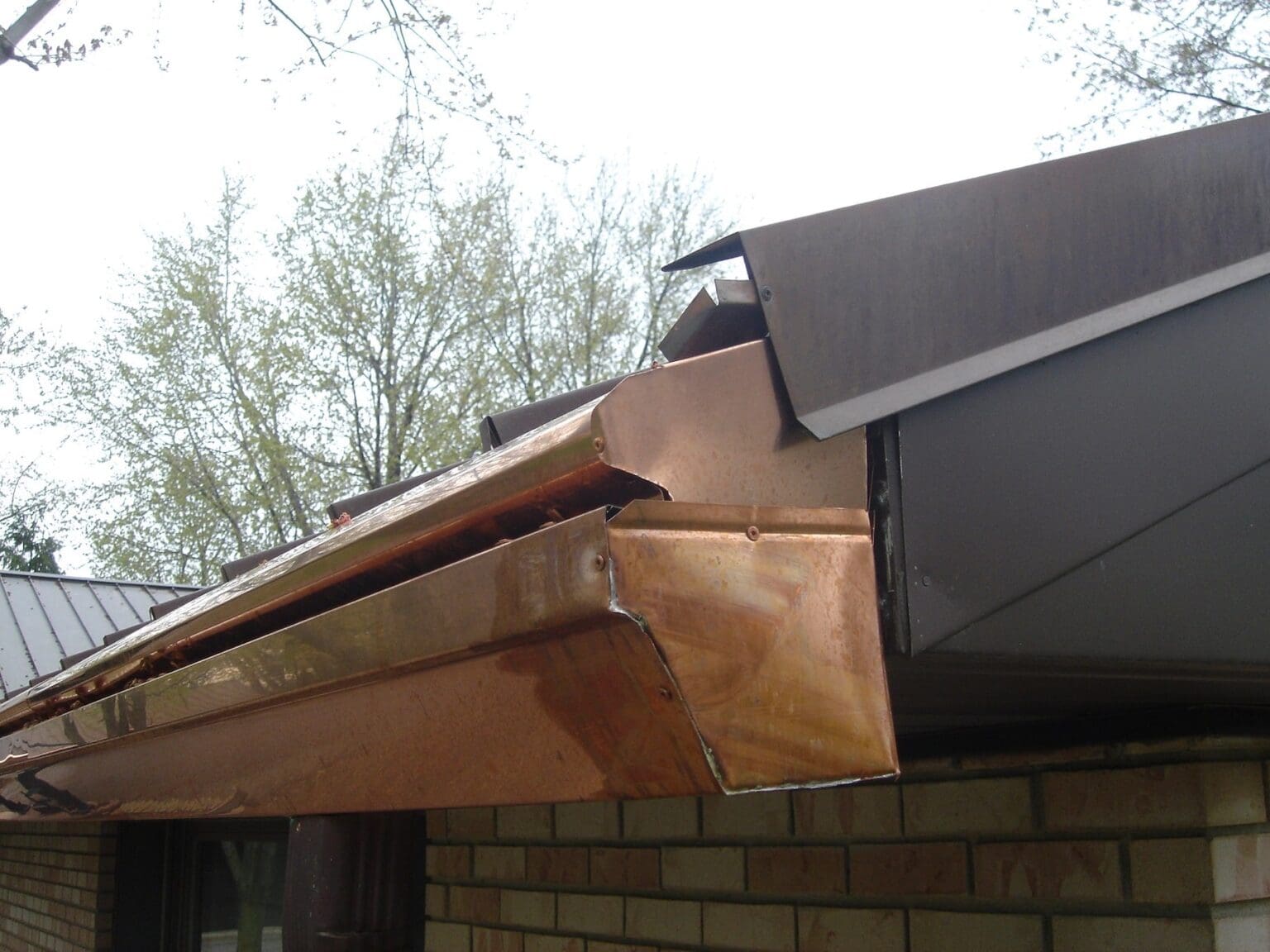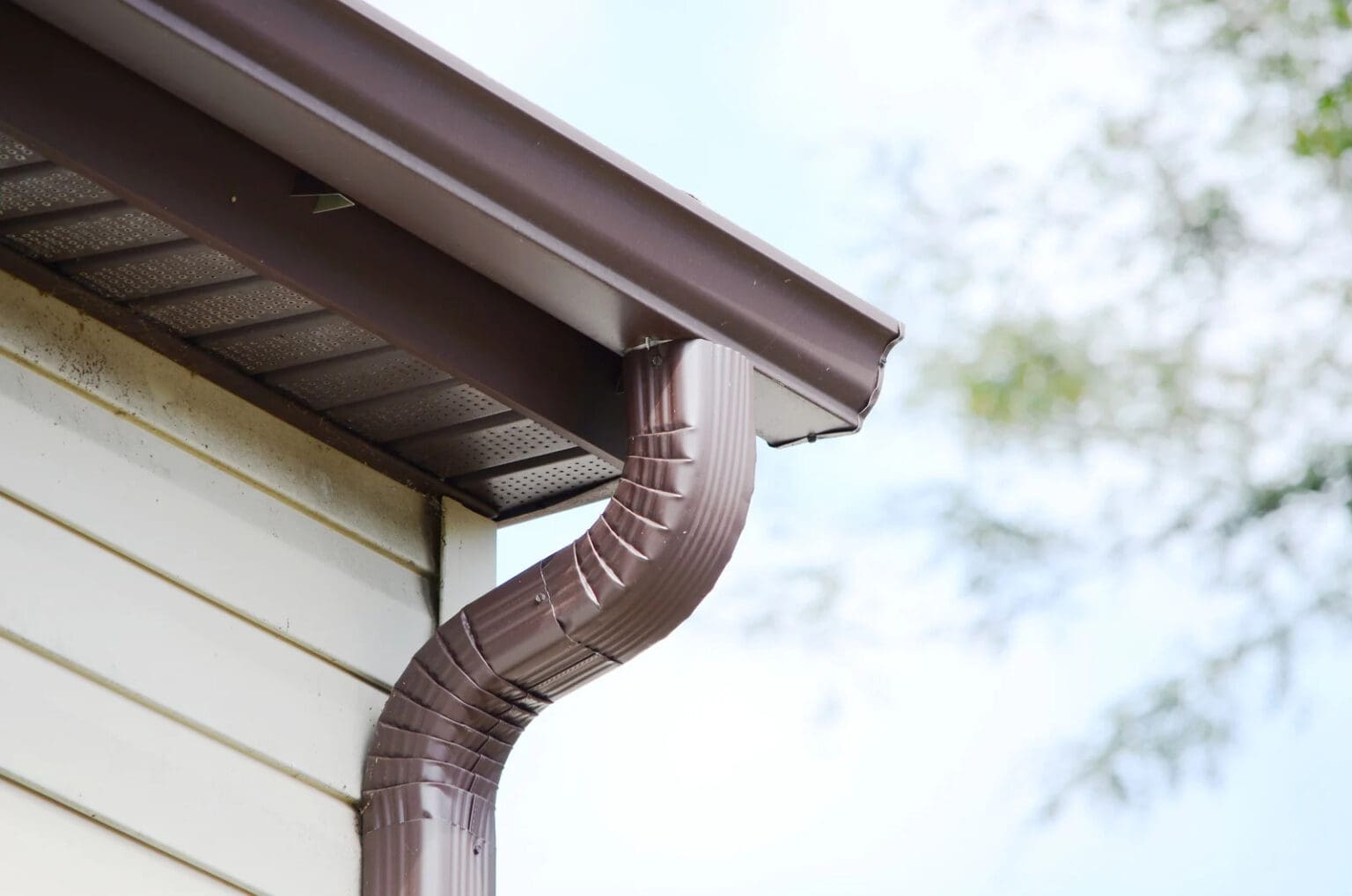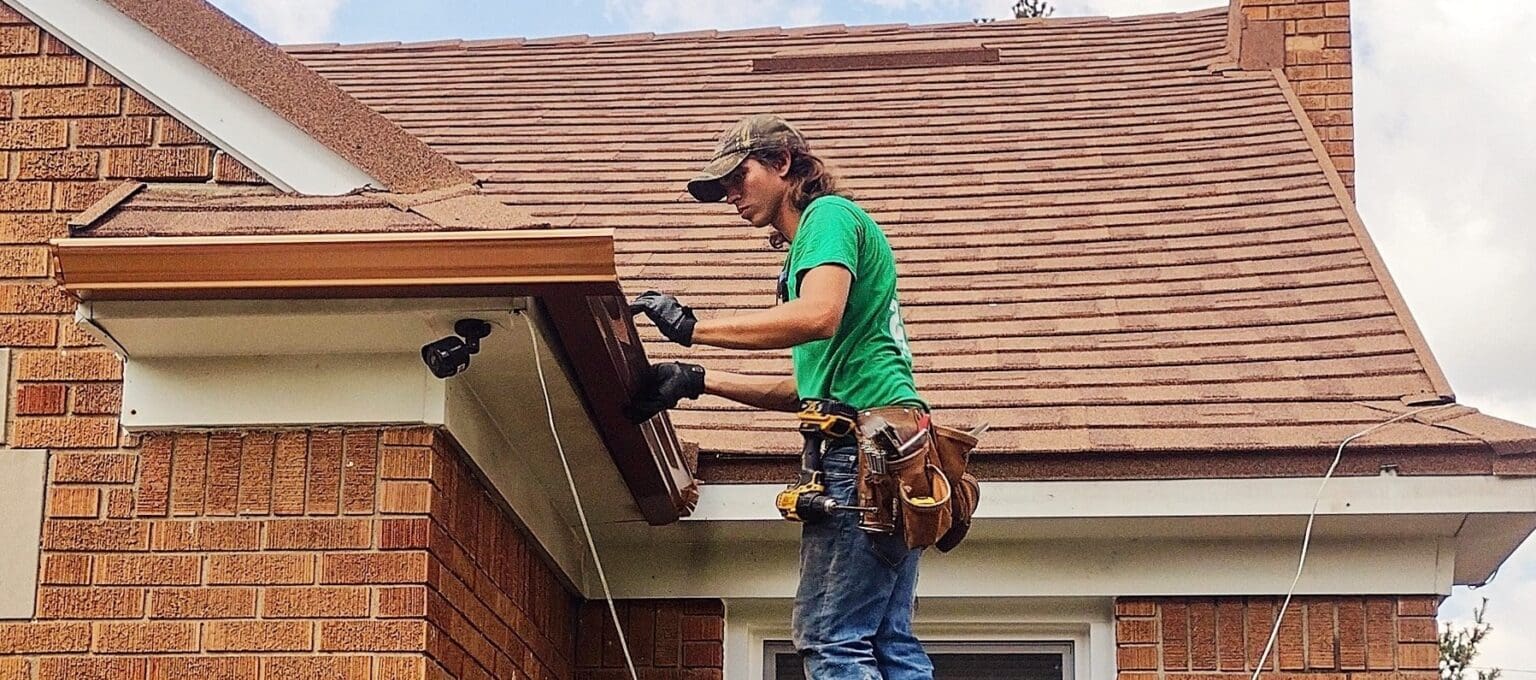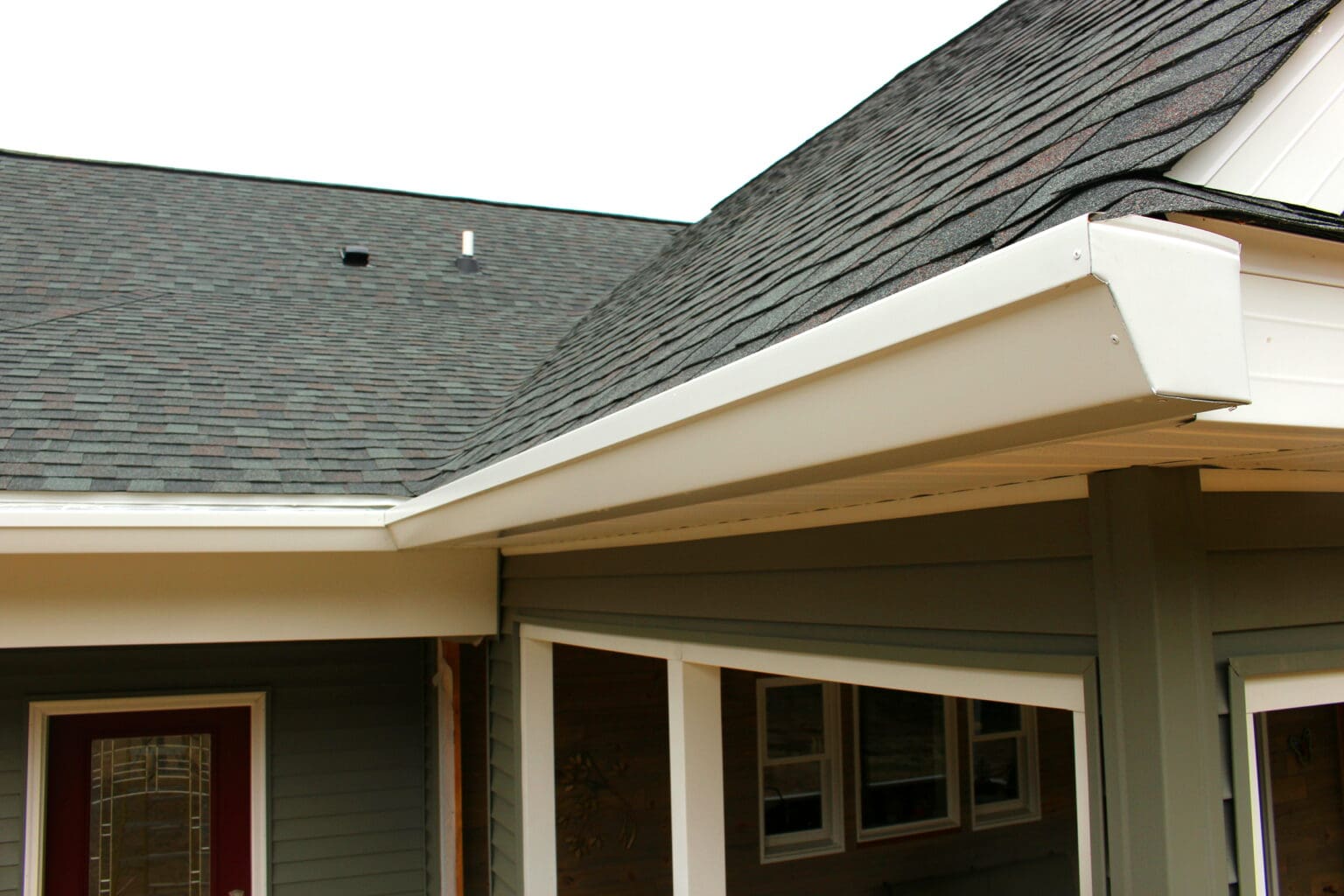REQUEST A FREE QUOTE TODAY
Gutters might not be the most glamorous part of your home’s exterior, but they play an essential role in protecting your investment. They guide rainwater away from your roof, siding, and foundation—preventing water damage, erosion, mold, and even basement flooding.
While most homeowners understand the need for gutters, many overlook one critical decision: choosing the right gutter material. From budget-friendly vinyl to architectural-grade copper, your gutter material impacts performance, lifespan, appearance, and maintenance requirements. This guide will help you choose the best gutter material, identify what kind you already have, and pick the best downspout style to match.

Gutter materials vary widely in cost, performance, and aesthetic appeal. Choosing the right one depends on your home’s climate, architectural style, and maintenance preferences.
Vinyl gutters are a low-cost solution favored for their ease of installation. They’re made from molded plastic, making them naturally resistant to rust, though their flexibility comes at the cost of durability in extreme cold or heat. Homeowners in temperate regions often use them for budget-conscious, short-term installations.
Aluminum gutters are valued for their adaptability and rust resistance. Available in a wide variety of factory-painted colors, they can be shaped into seamless runs that reduce leakage points. Though lightweight, they hold up well in most environments and strike a strong balance between affordability and function.
Steel gutters, either galvanized or stainless, are best known for their structural strength. Galvanized options are zinc-coated to delay rusting, while stainless steel offers long-term resistance without coating. Their heavier weight demands secure mounting and professional installation, making them a durable but more labor-intensive option.
Copper gutters stand out for their beauty and exceptional lifespan. Over time, they develop a signature green patina that enhances their historic or upscale appeal. Copper systems are custom-built, often soldered at the joints, and are an investment chosen for both their longevity and visual charm.
Zinc gutters offer understated elegance with long-term reliability. Popular in modern and European-style architecture, they naturally form a protective matte finish that prevents corrosion. Zinc requires expert handling during installation but needs minimal maintenance once in place.
Wood gutters are rare today but still used in historic restoration projects. Crafted from cedar, redwood, or other rot-resistant woods, they blend seamlessly into traditional rooflines. Though beautiful, they demand frequent upkeep and are generally impractical for contemporary homes.

If you’re unsure what your gutters are made of, a quick visual and physical inspection can reveal a lot. Use these identifying features to determine the material:
Pro Tip: Use a magnet—if it sticks, you likely have steel. If it doesn’t, your gutters may be aluminum, copper, vinyl, or zinc.

Once you know your existing material, consider the following before choosing to repair, replace, or upgrade:
Some materials like copper and zinc develop a weathered patina, while others (like aluminum) come in a variety of colors to match your home’s exterior.
Vinyl is the most affordable; copper and zinc are high-end investments. Aluminum strikes a good balance for most homeowners.
Steel and wood require more upkeep. Aluminum and vinyl are lower-maintenance.
Vinyl and aluminum are DIY-friendly. Copper, zinc, and steel should be installed professionally due to weight, complexity, or soldering requirements.
|
Material |
Pros |
Cons |
Best For |
|
Vinyl |
Affordable, rust-proof, DIY-friendly |
Cracks in cold, short lifespan |
Budget-conscious homeowners |
|
Aluminum |
Lightweight, rust-resistant, customizable |
Dents easily |
Most residential applications |
|
Steel |
Durable, handles snow and debris |
Can rust, heavy, costlier |
Harsh climates, commercial homes |
|
Copper |
Long lifespan, beautiful patina |
Expensive, pro install required |
Historic or high-end homes |
|
Zinc |
Durable, ages well, low maintenance |
Expensive, rare |
Modern architectural designs |
|
Wood |
Authentic, historic appeal |
High maintenance, short lifespan |
Historic restoration projects |

Your downspouts are just as important as the gutters themselves—they carry water away from your home’s foundation. Here’s what to consider when looking at downspout styles:
Choose rectangular for functionality and widespread compatibility. Choose round for upscale aesthetics and seamless water movement.
Standard downspout sizes range from:
Ensure your downspouts are sized properly for your roof pitch and rainfall volume to avoid overflow issues.
|
Material |
Cost ($/ft) |
Lifespan |
Maintenance |
Appearance |
Best For |
|
Vinyl |
4–8 |
10–15 yrs |
Low |
Basic, utilitarian |
Budget or DIY |
|
Aluminum |
6–12 |
20–30 yrs |
Low |
Customizable |
Most residential homes |
|
Steel |
9–20 |
15–25 yrs |
Medium |
Industrial |
Harsh weather zones |
|
Copper |
20–30 |
50+ yrs |
Low |
Elegant, patina |
Historic and luxury homes |
|
Zinc |
15–25 |
30–50 yrs |
Low |
Matte gray |
Long-term architecture |
|
Wood |
20–30 |
10–20 yrs |
High |
Classic heritage |
Historical renovations |
Seamless gutters minimize leaks and have a cleaner look. Available mostly in aluminum, they must be professionally cut on-site.
Some materials and shapes are better suited for guards. Consider guards if you’re in a leafy area to reduce clogs.
Stick with the same material and finish to maintain performance and aesthetics.
Choose painted options if you want a match now. Choose patina materials like copper if you prefer a natural aging look.
Choosing the right gutter system is more than a visual or budget decision—it’s a vital component of your home’s protection. Start by identifying what you have, then select a material and gutter style that suits your climate, architectural style, and maintenance comfort level.
Aluminum remains the go-to for most homes, while copper or zinc elevate appearance and longevity. Pair your choice with compatible downspouts—whether round, rectangular, vinyl, or metal—for a system that works beautifully and lasts.
Need help identifying or installing your system? Reach out to a licensed gutter specialist like Gutter Helmet of Southeast Michigan for a tailored recommendation. Contact us today!